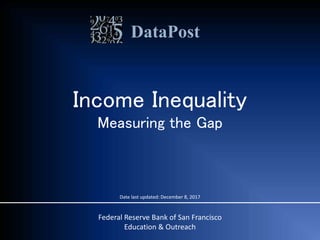Income Inequality: Measuring the Gap
•Download as PPTX, PDF•
1 like•578 views
Using median household income, learn about a method to track trends in income inequality.
Report
Share
Report
Share

Recommended
Recommended
2024 US Monetary Policy Forum2024 US Monetary Policy Conference Mary C. Daly Presentation Slides

2024 US Monetary Policy Conference Mary C. Daly Presentation SlidesFederal Reserve Bank of San Francisco
Who is active in the labor force? Behavioral patterns among teenagers, prime-age men and women, and older workers have important implications for the path of unemployment.Labor Force Participation Rates: Measuring workforce engagement

Labor Force Participation Rates: Measuring workforce engagementFederal Reserve Bank of San Francisco
More Related Content
More from Federal Reserve Bank of San Francisco
2024 US Monetary Policy Forum2024 US Monetary Policy Conference Mary C. Daly Presentation Slides

2024 US Monetary Policy Conference Mary C. Daly Presentation SlidesFederal Reserve Bank of San Francisco
Who is active in the labor force? Behavioral patterns among teenagers, prime-age men and women, and older workers have important implications for the path of unemployment.Labor Force Participation Rates: Measuring workforce engagement

Labor Force Participation Rates: Measuring workforce engagementFederal Reserve Bank of San Francisco
More from Federal Reserve Bank of San Francisco (20)
AI: Our Choices Matter 2024 US Monetary Policy Forum

AI: Our Choices Matter 2024 US Monetary Policy Forum
AI: Our Choices Matter 2024 US Monetary Policy Forum

AI: Our Choices Matter 2024 US Monetary Policy Forum
AI: Our Choices Matter 2024 US Monetary Policy Forum

AI: Our Choices Matter 2024 US Monetary Policy Forum
2024 US Monetary Policy Conference Mary C. Daly Presentation Slides

2024 US Monetary Policy Conference Mary C. Daly Presentation Slides
Recent Economic and Financial Developments by Sylvain Leduc

Recent Economic and Financial Developments by Sylvain Leduc
Gross Domestic Product (GDP): Measuring the Economy

Gross Domestic Product (GDP): Measuring the Economy
Labor Force Participation Rates: Measuring workforce engagement

Labor Force Participation Rates: Measuring workforce engagement
Recently uploaded
God is a creative God Gen 1:1. All that He created was “good”, could also be translated “beautiful”. God created man in His own image Gen 1:27. Maths helps us discover the beauty that God has created in His world and, in turn, create beautiful designs to serve and enrich the lives of others.
Explore beautiful and ugly buildings. Mathematics helps us create beautiful d...

Explore beautiful and ugly buildings. Mathematics helps us create beautiful d...christianmathematics
Recently uploaded (20)
Kodo Millet PPT made by Ghanshyam bairwa college of Agriculture kumher bhara...

Kodo Millet PPT made by Ghanshyam bairwa college of Agriculture kumher bhara...
Explore beautiful and ugly buildings. Mathematics helps us create beautiful d...

Explore beautiful and ugly buildings. Mathematics helps us create beautiful d...
Russian Escort Service in Delhi 11k Hotel Foreigner Russian Call Girls in Delhi

Russian Escort Service in Delhi 11k Hotel Foreigner Russian Call Girls in Delhi
Food safety_Challenges food safety laboratories_.pdf

Food safety_Challenges food safety laboratories_.pdf
Asian American Pacific Islander Month DDSD 2024.pptx

Asian American Pacific Islander Month DDSD 2024.pptx
ICT role in 21st century education and it's challenges.

ICT role in 21st century education and it's challenges.
Income Inequality: Measuring the Gap
- 1. DataPost Income Inequality Measuring the Gap Date last updated: December 8, 2017 Federal Reserve Bank of San Francisco Education & Outreach
- 2. Household (HH) Income A Snapshot of 2016 U.S. Households Bottom 10% $13,608 10th percentile (P10) 10% of HHs earned this amount or less Median (Middle) $59,039 Top 10% $170,536 90th percentile (P90) 90% of HHs earned this amount or less DataPost 50th percentile (P50) 50% of HHs earned this amount or less, 50% earned this amount or more www.frbsf.org/education/teacher-resources/datapost FRBSF Education & Outreach
- 3. $0K $50K $100K $150K $200K 10th (P10) 90th (P90) This means that household income at the 90th percentile is over 12 times household income at the 10th percentile. In 1990, the P90/P10 ratio was 10.12. DataPost Source: U.S. Census Bureau, pre-tax/transfer HH income in 2016 CPI-U-RS adjusted dollars U.S. Household Income in 2016 P10 = $13,608 P90 = $170,536 The P90/P10 Ratio A Measure of Income Inequality = = 12.53 P90 $170,536 P10 $13,608 One way to highlight the difference between the high end and the low end of the income distribution is to create a ratio of the 90th and 10th percentiles. www.frbsf.org/education/teacher-resources/datapost FRBSF Education & Outreach
- 4. 8.0 8.5 9.0 9.5 10.0 10.5 11.0 11.5 12.0 12.5 13.0 1967 1972 1977 1982 1987 1992 1997 2002 2007 2012 2017 Inequality in Household Incomes P90/P10 Ratio (1967–2016) Source: U.S. Census Bureau, pre-tax/transfer HH income DataPost www.frbsf.org/education/teacher-resources/datapost FRBSF Education & Outreach
- 5. 8.0 8.5 9.0 9.5 10.0 10.5 11.0 11.5 12.0 12.5 13.0 1967 1972 1977 1982 1987 1992 1997 2002 2007 2012 2017 Annotated Chart Notes Inequality in Household Incomes P90/P10 Ratio (1967–2016) Source: U.S. Census Bureau, pre-tax/transfer HH income Starting in 1975 income inequality in the U.S. started to pick up quite substantially. Between 1967 and 1979, the household income distribution was up and down, but largely flat. 12.53 in 2016 (See slide 3) DataPost 10.12 in 1990 (See slide 3) The trend accelerated during and after the Great Recession. www.frbsf.org/education/teacher-resources/datapost FRBSF Education & Outreach
- 6. What are the Facts? 1. In 2016, what percentage of U.S. households earned $170,536 or more? (See slides 2 or 3) 2. In 2016, what income level was at the 10th percentile? (See slides 2 or 3) 3. What was the P90/P10 ratio in the year you were born? (See slide 4) 4. In which year was the P90/P10 ratio the lowest? The highest? (See slide 4) 5. What has been the trend in the P90/P10 ratio since 1975? (See slide 4) 6. What does the P90/P10 ratio tell us about household incomes? View in-depth talks on income inequality by visiting the FRBSF Economics in Person video series DataPost www.frbsf.org/education/teacher-resources/datapost FRBSF Education & Outreach
Editor's Notes
- Data source: https://www.census.gov/content/dam/Census/library/publications/2017/demo/P60-259.pdf (Table A-2)
- Data source: https://www.census.gov/content/dam/Census/library/publications/2017/demo/P60-259.pdf (Table A-2)
- Data source: https://www.census.gov/content/dam/Census/library/publications/2017/demo/P60-259.pdf (Table A-2)
- Data source: https://www.census.gov/content/dam/Census/library/publications/2017/demo/P60-259.pdf (Table A-2)
